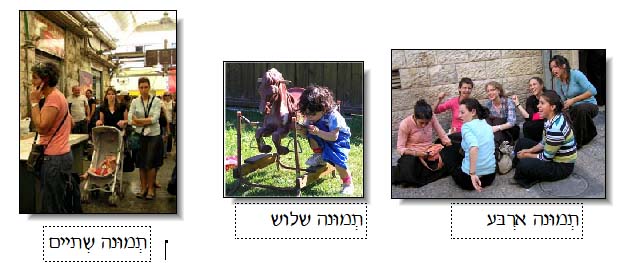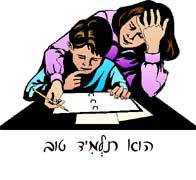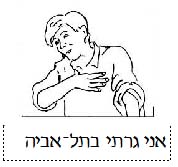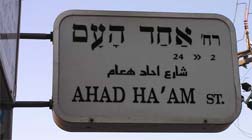2.9.2 כמה יֵש - Counting Things
מי יודֵעַ לִסְפּור מֵאחת עד עֶשֶׂר?
![]()
Be sure to respond with a complete sentence ?
כמה יֵש1.
How many students (f) are in the class? יש ______סטוּדנְטִיות בּכּיתה2.
How many women are in the picture יש ______נשים בּתמוּנה3.
How many girls are in the picture? יש ______יְלדות בּתמוּנה4. How many young women are in the picture? יש ______בנות בּתמוּנה
5. Can you write down your telephone number using the Hebrew words for the numbers?
________________________

2.9.3 מה השעה? - What time is it?
![]() Use with the Software Chapter 2 Drill3
"Telling Time in Hebrew"
Use with the Software Chapter 2 Drill3
"Telling Time in Hebrew"
For now we will only tell time for the quarter hour, half hour, or hour.
When you answer the question.
?מה השעה
You don't have to say the word "השעה"
("the
hour"). Look in the boxes below the clocks for options..
100.00 %
Remember to use the feminine gender for numbers
when telling time. 89
2.9.4
2.10 Hebrew has ten subject pronouns. In this
list you see the
forms that your instructor has already been using in class. They are the
singular forms.
100.00 %
שְמות הגוּף-
(יחיד) אֲנִִי אתה אתְ הוּא
הִיא
2.10.1
צוּרת
יסוד
- The Citation Form of the Verb -
When we refer to a verb, we will usually "cite" it (refer to it) using
the Hebrew verb-form that we would use with the pronoun "he"
This form is called the citation form. For
example, he studied — 90
2.10.2
התְאמה
- Subject-Verb Agreement in the Past Tense
Subject-Verb Agreement in the Past Tense for one and two syllable verbs Study the examples
below for the pronouns הוּא
and
אני.
Are there similarities in the vowels of the different verbs you see
below for
אני
? Try to create the rule for forming the past tense form of the verb
למד
when used with אני
.
As you can see from these examples, you don't have to say
אני to
understand who the verb is referring to.
100.00 %
CITATION (base) FORM
Two - Syllable
Verbs
למדְתִי עִבְרית
אני למדְתִי
הוּא למד
למד
(
ל + מד
)
ידעְתִי עבְרית
אני ידעְתי
הוּא ידע ידע
( י
+ דע)
כתבְתי מיכְתב
אני כּתבְתי
הוּא
כּתב
כּתב
(
כּ
+
תַב
)
שכחְתי עברית
אני שכחְתי
הוּא שכח שכח
(
ש
+
כח)
One - Syllable
Verbs
גרְתי בְתֵל־אביב
אני גרְתי
הוּא גר
גר
אני - Study how the verbs are formed in the
sentences below:
הוּא למד
אני למדְתִי עִבְרית
I studied Hebrew
למדְתִי עִבְרית
I studied Hebrew
הוּא ידע
אני ידעְתי עבְרית
ידעְתִי עבְרית
I knew Hebrew
הוּא
כָתַב
אני
כּתבְתי מיכְתב לְאבּא
כתבְתי מיכְתב לְאבּא
הוּא שָכח
כבר שכַחְתי עברית
הוּא גָר אני
גרְתי בְתֵל
גרְתי בְתֵל 91 Observations
CORRECT: He said hello הוא
אמר שלום
NOT CORRECT: :
אמְרה
שלום or
אמר שלום.
2.10.3
הוּא, היא, אתה, את- זמן עבר
- Past Tense, Second Person and Third Person
You MUST listen to the audio first to be able to
figure out the rules asked for below!
How do you read the past tense verbs for
IMPORTANT! for both "you" masculine
אתה
and" you" feminine
את
the last letter of the verb (past tense) will be a
ת
. But - for the masculine form of the verb the
ת
is pronounced /tah/ .
For the feminine form
ת
is pronounced /
t/. There will be no vowel
sign given under the
ת
so you just have to know this. It is easy to remember because the
pronunciation of the words
אתה and
את
give you the clue.
100.00 %
Past Tense: Second Person = "you
" אַתָה
\
אַת Third Person =
"she"
הִיא
\
"he"
הוּא
למדְת
אַת
לָמַדְת
אַתָה
כּתַבְת
אַת
כּתַבְת
אַתָה
ידַעְת
אַת ידַעְת
אַתָה
גרְת
אַת
גרְת
אַתָה
למְדה
הִיא
למד הוּא
כּתְבה
הִיא
כתב
הוּא
ידְעה
הִיא
ידע הוּא
גרה
הִיא
גר הוּא
92
Here are some sample sentences. Listen to the audio and then read the
sentences out loud.
100.00 %
Where did you (ms)
study Hebrew, Dan?
איפה למדְת עִבְרית, דן Rina, where did
you (fs) learn Hebrew?
רינה, איפה
למדְת עִבְרית
Yosef, to whom did you (ms) write a
letter?
יוסף, לְמי
כּתבְת מיכְתב
To whom did you (ms) write a letter,
Yosef?
למי כּתבְת מיכתב, יוסף?
How did you (ms) know, Chaim?
אֵיךְ ידעְת, חיים
How did you (fs) know, Ruth?
אֵיךְ ידעְת,
רוּת What did she (fs)
write?
מה היא
כּתְבה Where did you (ms)
live?
איפה גרְת Observations When the verb
comes before the subject the reader
has to look ahead in order to know how to read it.
Obviously, when no vowel marks are written, then if the subject
is mentioned at the beginning of the sentence and not after the verb, it's
easier to decide how to read a form like
Write in /t/ or /tah/ to indicate how
you would pronounce the verb ending.
אֵיפֹה למדְת עברית, רינה?
לְמי
כּתבְת מיכְתב, דפְנה?
כתבְת את הסֵפֶר, רינה?
כתבְת את הסֵפֶר, דוד?
93
Using the Citation (base) form shown, write in the correct form of
the verb for the pronoun given at the top of the lines.
היא
אני
אתה
את
הוּא למד
_________ _________ _________
_________
הוּא ידע
_________ _________ _________
_________
הוּא
כתב
_________ _________ _________
_________
הוּא שכח
_________ _________ _________
_________
הוּא גר
_________ _________
_________ _________
Try filling in the blanks. There are three new words that follow the
same vowel patterns you have learned.
הוּא רץ
היא _______________
הוּא גר
אני _________ ברחוב אחד העם
הוּא שמע את
_____________
הוּא אכל אתה
_________________
94 
![]() Now look at the clocks below and write
in words in Hebrew the time you see
on the face of each clock.
Now look at the clocks below and write
in words in Hebrew the time you see
on the face of each clock.
![]() Use with the Software Chapter 2:8 "Past
Tense Verbs and Pronouns"
Use with the Software Chapter 2:8 "Past
Tense Verbs and Pronouns"



כּתב
כּתבְתי
שכח
שכַחְתי
She said hello
היא אמְרה שלום
![]() Use with the Software Chapter 2:9 "Dictation:
Past Tense Verbs"
Use with the Software Chapter 2:9 "Dictation:
Past Tense Verbs"
![]()

![]()




2.11 Combining the one-word prepositions with the word "the"
הֶעָרָה
FYI לידיעתך
We mean the number of syllables in the Citation Form. For example in the verb למד "he learned," there are two syllables: la + mahd. In this lesson we are only working with verbs that have the vowels /ah/ + /ah/ in the two syllables.